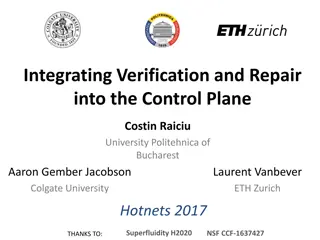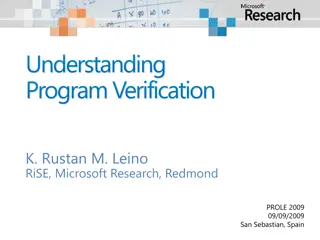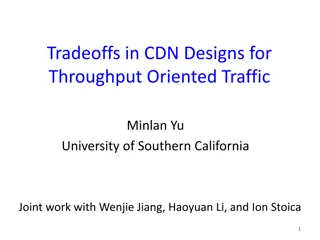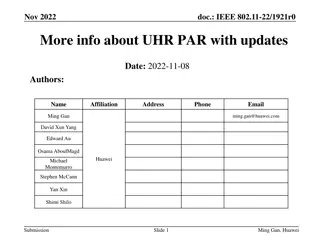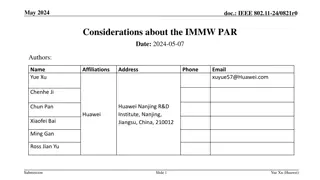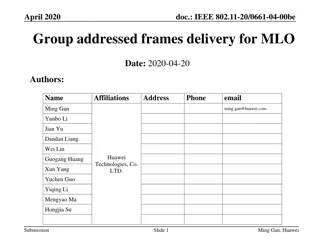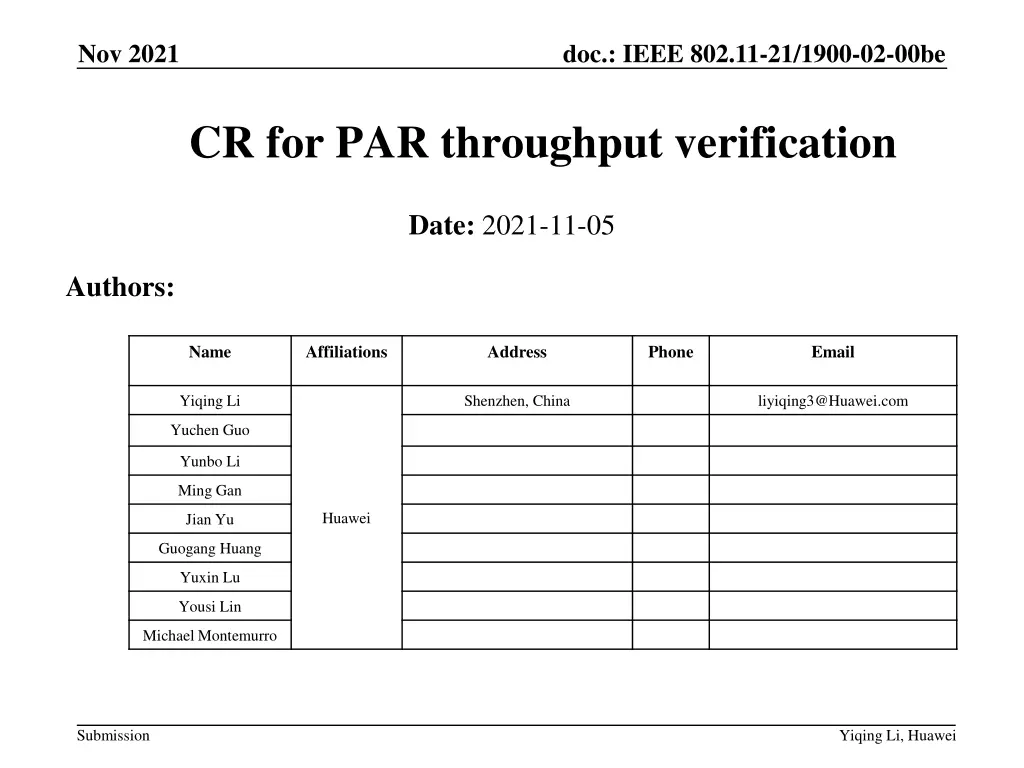
IEEE 802.11-21/1900-02-00be PAR Throughput Verification
Explore the details of throughput verification for IEEE 802.11-21/1900-02-00be, aiming to achieve a maximum throughput of 30 Gbps with specific R1 features. The document discusses simulation results, proposed changes, and necessary features like Multi-Link, 4KQAM, and more. Discover the simulation setup parameters, simulation cases comparing 11ax vs. EHT features, and insights into achieving the targeted throughput outlined in the project.
Download Presentation

Please find below an Image/Link to download the presentation.
The content on the website is provided AS IS for your information and personal use only. It may not be sold, licensed, or shared on other websites without obtaining consent from the author. If you encounter any issues during the download, it is possible that the publisher has removed the file from their server.
You are allowed to download the files provided on this website for personal or commercial use, subject to the condition that they are used lawfully. All files are the property of their respective owners.
The content on the website is provided AS IS for your information and personal use only. It may not be sold, licensed, or shared on other websites without obtaining consent from the author.
E N D
Presentation Transcript
Nov 2021 doc.: IEEE 802.11-21/1900-02-00be CR for PAR throughput verification Date: 2021-11-05 Authors: Name Affiliations Address Phone Email Yiqing Li Shenzhen, China liyiqing3@Huawei.com Yuchen Guo Yunbo Li Ming Gan Huawei Jian Yu Guogang Huang Yuxin Lu Yousi Lin Michael Montemurro Submission Yiqing Li, Huawei
Nov 2021 doc.: IEEE 802.11-21/1900-02-00be CID 7619 CID Commenter Clause Number Page. Line Comment Proposed Change Resolution 7619 Tomoko Adachi Verification is needed to see how much throughput can be achieved by R1 features. By doing this, we can think of how to achieve 30 Gb/s throughput and what kind of features are required at the end in P802.11be. As in the comment. Rejected. Note to commenter. This comment is rejected since it does not result in a change to the draft. For the 30Gbps throughput verification, four R1 features as Multi-Link, 4KQAM, 1024 MPDU Aggregation per A-MPDU, 320MHz bandwidth guarantee 30Gbps for SU and MU cases and achieve the goal setout in the PAR for the project. Please refer to https://mentor.ieee.org/802.11/dcn/21/11- 21-1900-02-00be-cr-for-par-throughput- verification.pptx for detailed simulation results. Submission Yiqing Li, Huawei
Nov 2021 doc.: IEEE 802.11-21/1900-02-00be PAR Doc: 11-18-1231-06-802.11 EHT Proposed PAR[1] Capable of supporting a maximum throughput of at least 30 Gbps, as measured at the MAC data service access point (SAP), with carrier frequency operation between 1 and 7.250 GHz while ensuring backward compatibility and coexistence with legacy IEEE Std. 802.11 compliant devices operating in the 2.4 GHz, 5 GHz, and 6 GHz bands at least one mode of operation capable of improved worst case latency and jitter. Submission Yiqing Li, Huawei
Nov 2021 doc.: IEEE 802.11-21/1900-02-00be How much throughput can be achieved by R1 features R1 features that are considered in the simulation. Multi-Link (with 2 links), 4KQAM, 1024 MPDU Aggregation per A-MPDU, 320MHz Throughput is measured at MAC data SAP. Simulation Setup Parameters Default value Simple scenario: 1 AP MLD and 1 non-AP MLD The number of AP MLD 1 The number of non-AP MLD 8 PPDU AP 1 The size of area 20m*20m Link 1 STA 1 ACK Traffic type Full buffer UL/DL traffic AP MLD 1 Non-AP MLD 1 Packet size 1500 Bytes per MPDU 20dbm for AP MLD; 15dbm for PPDU AP 2 Link 2 TX power ACK STA 2 non-AP MLD NSS 8 CWmax 15 20m CWmin 7 AIFS 34us The number of links 2 (5GHz&6GHz) TXOP 4.096ms RTS/CTS 10m on Topology: 20m*20m 0 20m 10m Submission Yiqing Li, Huawei
Nov 2021 doc.: IEEE 802.11-21/1900-02-00be 11ax vs Individual EHT Features Simulation cases Aggregation Link # Bandwidth (MHz) QAM Case 1-1 256 1 160 1K Case 1-2 1024 1 160 1K Case 1-3 256 1 160 4K Case 1-4 256 1 320 1K Case 1-5 256 2 (160MHz for link 1 + 160MHz for link 2) 160 1K Gain versus Case 1-1 Case 1-2 Case 1-3 Case 1-4 Case 1-5 18000 16000 DL SU 41.57% 11.65% 43.76% 100.33% 14000 Throughput/Mbps UL SU 40.91% 11.76% 41.72% 100.46% 12000 DL MU 10.55% 15.73% 69.18% 99.59% 10000 8000 UL MU 6.04% 17.86% 80.50% 99.93% 6000 4000 Case 1-1 combines 11ax features, i.e., 256 aggregation for A- MPDU, one link with 160MHz bandwidth, 1KQAM. For the MU case, each non-AP STA affiliated with non-AP MLD is 1 NSS with 8 non-AP MLDs in total. No individual feature achieves the target throughput mentioned in the PAR, under these conditions. Case 1-4 (320 MHz) and Case 1-5 (MLO with 2 links) have better performance. The gain increases in order as 4KQAM, 1024 aggregation, 320MHz, Multi-Link. 2000 0 Case 1-1 5522.1 5525.1 7667.1 8384.484 Case 1-2 7817.58 7785.276 8475.96 8891.136 Case 1-3 6165.336 6174.756 8873.124 9858.912 Case 1-4 7938.756 7830.18 12970.968 15133.884 Case 1-5 11062.26 11075.652 15331.08 16762.956 DL SU UL SU DL MU UL MU DL SU UL SU DL MU UL MU Submission Yiqing Li, Huawei
Nov 2021 doc.: IEEE 802.11-21/1900-02-00be Combinations of two EHT R1 features Simulation cases Aggregation Link # Bandwidth(MHz) QAM Case 2-1 1024 1 320 1K Case 2-2 1024 2 (160MHz for link 1 + 160MHz for link 2) 160 1K Case 2-3 1024 1 160 4K Case 2-4 2 (320MHz for link 1 + 160MHz for link 2) 256 320 1K Case 2-5 2 (320MHz for link 1 + 320MHz for link 2) Case 2-6 256 2 (160MHz for link 1 + 160MHz for link 2) 160 4K Case 2-7 256 1 320 4K Gain versus Case 1-1 Case 2-1 Case 2-2 Case 2-3 Case 2-4 Case 2-5 Case 2-6 Case 2-7 35000 DL SU 147.71% 180.99% 65.99% 144.01% 183.27% 121.65% 55.22% 30000 Throughput/Mbps 25000 UL SU 147.38% 182.80% 65.93% 141.82% 183.07% 122.93% 53.96% 20000 DL MU 120.20% 121.11% 32.61% 168.91% 238.09% 131.48% 91.28% 15000 UL MU 110.87% 112.10% 27.23% 180.86% 261.19% 135.22% 108.63% 10000 5000 0 Case 2- 1 13678.9 15517.09 9166.296 13474.52 15642.53 12239.64 8571.756 UL SU 13668.12 15624.71 9167.904 13360.96 DL MU 16883.29 16952.84 10167.85 20618.2 25922.2 17747.65 14665.82 UL MU 17680.14 17783.7 10667.95 23548.66 30283.68 19722.35 17492.29 Case 2- 2 Case 2- 3 Case 2- 4 Case 2- 5 Case 2- 6 Case 2- 7 There are two different cases when combining two links with 320MHz bandwidth labeled as case 2-4 and case 2-5. Case 2-5 (MLO with 2 320 MHz links) for UL MU achieves 30Gbps due to higher transmission efficiency. DL SU 15640 12317.38 8506.296 DL SU UL SU DL MU UL MU Submission Yiqing Li, Huawei
Nov 2021 doc.: IEEE 802.11-21/1900-02-00be Combination of three or four EHT R1 features Simulation cases Aggregation Link # Bandwidth (MHz) QAM Case 3-1 1024 1 320 4K Case 3-2 2(320MHz for link 1 + 160MHz for link 2) 256 320 4K Case 3-3 2(320MHz for link 1 + 320MHz for link 2) Case 3-4 1024 2(160MHz for link 1 + 160MHz for link 2) 160 4K Case 3-5 2(320MHz for link 1 + 160MHz for link 2) 1024 320 1K Case 3-6 2(320MHz for link 1 + 320MHz for link 2) Case 4-1 2(320MHz for link 1 + 160MHz for link 2) 1024 320 4K Case 4-2 2(320MHz for link 1 + 320MHz for link 2) Case 5 1024 3(320MHz for link 1 + 160MHz for link 2 + 160MHz for link 3 ) 320 4K 45000 With three combined R1 features, case 3-3 for UL MU, case 3-6 for MU cases achieves 30Gbps. With four combined R1 features, case 4-2 for both MU and SU cases achieves 30Gbps. Multiple links with 320MHz improve throughput Case 4-2 has 262.77%, 270.36%, 373.70%, 401.76% throughput gain in DL SU, UL SU, DL SU and UL MU respectively compared with case 1-1 with four R1 features combined. In case 5, three links are applied by adding one link with 160MHz based on case 4-1 and it achieves 30Gbps for both MU and SU cases. Adding links improves the throughput compared with case 4-1. 40000 Throughput/Mbps 35000 30000 25000 20000 15000 10000 5000 0 Case 3-1 Case 3-2 Case 3-3 Case 3-4 Case 3-5 Case 3-6 Case 4-1 Case 4-2 15701.29 14734.09 17155.36 18322.45 21473.1 26710.88 24748.63 30416.12 33537.06 15537.12 14688.96 16954.93 18302.82 21435.11 27109.2 24881.12 31052.58 32823.04 DL MU 19830.22 23495.08 29257.69 20341.98 25307.35 33764.38 30041.38 39717.17 38911.1 UL MU 21012.6 27356 34998.55 21331.97 26659.91 35457.07 31669.9 42069.83 40570.56 Case 5 DL SU UL SU DL SU UL SU DL MU UL MU Submission Yiqing Li, Huawei
Nov 2021 doc.: IEEE 802.11-21/1900-02-00be Throughput performance with varying traffic rate Adopt 1024 aggregation for A-MPDU, 2 links (320MHz for link 1 + 320MHz for link 2) and 4KQAM in UL MU MIMO case. Vary the traffic rate and the number of non-AP MLDs. Traffic Rate (Gbps) 0.1 3.5 4 5 6 7 8 9 10 12 14 16 18 20 22 15.0123 19.6703 22.9616 25.4602 27.4043 28.9793 31.3975 32.8893 34.2942 35.0681 35.1356 35.1077 2 non-AP MLDs 0.19974 6.98244 8.1027 16.0045 23.5776 29.1083 32.4679 35.4538 37.4762 4 non-AP MLDs 0.39984 13.973 38.884 39.2018 39.416 39.3573 39.178 39.2449 39.3014 27.8695 31.5976 39.9895 41.3457 41.5174 41.8953 41.3567 41.6605 41.9004 41.6343 41.7427 41.8355 41.4449 41.5577 8 non-AP MLDs 0.7992 45 Traffic rate is the packet generation ratio for all links at the transmitter. In UL MU MIMO case, each affiliated non-AP STA is 4 NSS when the number of non-AP MLDs is 2. Similarly, 2 NSS for each affiliated non-AP STA when there are 4 non-AP MLDs and 1 NSS for each affiliated non-AP STA with total 8 non-AP MLDs. Throughput increases with increasing traffic rate until it reaches the saturation due to the limited PHY data rate since the bandwidth, MCS and NSS are fixed. Throughput increases with increasing number of non-AP MLD due to the transmission overhead in MU cases. Larger number of non-AP MLD reaches throughput saturation faster. 40 35 Throughput/Gbps 30 25 20 15 10 5 0 0.1 3.5 4 5 6 7 10 12 14 16 18 20 22 Traffic rate/Gbps 8 9 2 non-AP MLDs 4 non-AP MLDs 8 non-AP MLDs Submission Yiqing Li, Huawei
Nov 2021 doc.: IEEE 802.11-21/1900-02-00be Summary The contribution provides simulation results to show how much throughput can be achieved by combining R1 features. Multi-Link, 4KQAM, 1024 Aggregation for A-MPDU, 320MHz bandwidth Combining all four R1 features achieves 30Gbps for both SU and MU cases. Multi-Link with two links using 320MHz channels and 1024 aggregation for the UL MU case achieves 30Gbps throughput. Generally, the impact on throughput for EHT features from lowest to highest is: 4KQAM, 1024 aggregation, 320MHz, Multi-Link. (i.e. Multi- Link achieves greater throughput gain when compared with 4KQAM). Submission Yiqing Li, Huawei
Nov 2021 doc.: IEEE 802.11-21/1900-02-00be Reference 1. P802.11be (EHT) PAR - https://development.standards.ieee.org/myproject- web/public/view.html#pardetail/6886 Submission Yiqing Li, Huawei
Nov 2021 doc.: IEEE 802.11-21/1900-02-00be SP Do you agree to resolve CID 7619 with the resolution shown on Slide 2? Submission Yiqing Li, Huawei



